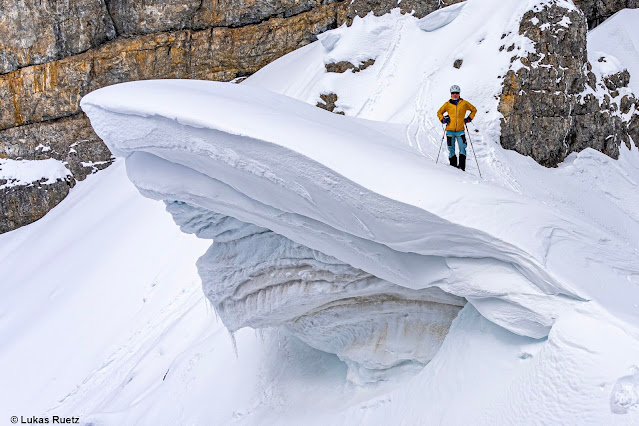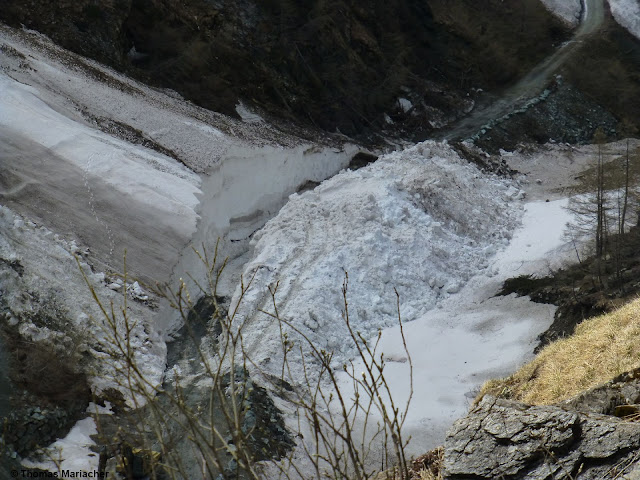Sudden warmth impulse harbors heightened wet-snow avalanche potential
Still lots of snow in the mountains
The ZAMG Weather Service today published a notice of striking and powerful impulses of warmth which will bring about increased snowmelt between Sunday, 9 May and latest Wednesday, 12 May. It is a result of the still immense amounts of snow on the ground at this juncture of the season. Particularly on shady slopes, above-average snow depths are evident down to intermediate altitudes. The situation at very high altitudes is similar in all aspects.
 |
| Overall snow depths on 6 May 2021 |
 |
Quite characteristic portrait of the snow situation at intermediate altitude: south-facing slopes are bare, on north-facing slopes descents are often skiable right down to the point of departure. Northern Stubai Alps
(photo: 30.04.2021) |
 |
| In the meantime, 1961 record-breaking snow depths in Obertilliach flat terrain have long been passed... |
Caution: heightened avalanche danger due to warmth and prognosticated rain!
Relevant to risk: this weather forecast means increasing avalanche activity.
 |
| Warmth over the next few days will lead to more frequent avalanches. Photo from Defereggental on 29.04.2021 |
Following the cold front (which passed through Tirol on Thursday night, 6 May, bringing 10 to 30 cm of fresh snow) weather conditions are expected to improve swiftly and radically, bringing numerous loose-snow avalanches in extremely steep terrain on Saturday at latest.
 |
| Fresh snow forecast for 6-7 May |
Particularly in wind-protected ridgeline terrain, the likelihood will increase that backcountry skiers and freeriders will trigger the snowdrift accumulations at high altitude. Starting on Sunday, 9 May, a day on which veritable summertime temperatures of 0° at 3900m are expected to be reached, the moistening of the snowpack will progress rapidly. More than anywhere else on shady slopes where moistening previously had not penetrated deep down into the snowpack, avalanches can then fracture down to deep layers and grow to dangerously large size. (Caution also urged on forest roads and hiking trails below higher-altitude starting zones!) The danger of such avalanches is expected to ratchet up a further notch on Monday evening, 10 May, when rainfall up to 3000 m is anticipated on the Main Alpine Ridge, coming from the south. Fractures of slab avalanches are then possible above about 2400m.
At high altitudes on shady slopes, a treacherous avalanche situation (dp.4 – cold on warm) could develop.
An avalanche release on the steep flank of the Petersenspitze in the rear Pitztal indicates a near-surface weak layer which was possibly formed through the swift development of danger pattern “cold-on-warm” occurring at altitudes around 3000m. Equally conceivable, although somewhat less likely in this case, is a massive layer of graupel generated during the brief bout of snowfall. Currently, we lack snowpack analysis at this altitude to be certain.
 |
| A slab avalanche triggered during the descent of winter sports enthusiasts. The striking altitude drop in the middle of the slope is probably the result of dp.4 (cold-on-warm). |
Review of last week
Highly variable
Several times in sequence, and now once again, we must call the past week ‘highly variable.’ And not only the weather was variable, so were avalanche conditions.
 |
| Unseasonably cool, repeated rounds of precipitation, two days of beautiful weather, very windy most of the time in the mountains |
Loose-snow and slab avalanches, yes, but also great conditions and powder snow.
Friday, 30 April, was quite a ‘steamy’ day in North Tirol. Clouds dispersed following nighttime precipitation. Solar radiation was diffuse, the sudden impulse of warmth was sharp in the snowpack. In retrospect, it was a day with frequent avalanches, including slab avalanches in the expected altitude zones. Frequently, slab avalanches were themselves triggered by loose-snow avalanches.
 |
| Cloudbanks clinging to mountain flanks amid sunshine lead to increased longwave outgoing radiation and, thereby, to faster moistening of the snowpack. Griesskogel Massif (photo: 30.04.2021) |
 |
| Just after the above photo was taken, an avalanche triggered naturally. Initially, a loose-snow avalanche. Then it became a slab avalanche Griesskogel Massif (photo: 30.04.2021) |
 |
| Slab-plus-loose-snow avalanches, northern Stubai Alps (photo: 30.04.2021) |
 |
On 1 May a slab avalanche triggered just below the rocks on a shady slope due to advanced moistening.
It led to a rescue operation. No one was buried. Axamer Lizum (photo: 01.05.2021) |
 |
| This photo is also from the Axamer Lizum, taken on 4 May. The avalanche releases probably occurred on 30 April – 1 May. |
A cold front brought fresh snow on 2-3 May. Part of it was (briefly) terrific powder at high altitude.
 |
| 48-hr snow depth differences: snowfall since the evening of 1 May |
 |
| We don’t want to create a false impression. There were also plenty of great conditions last week. Above, dream-come-true powder snow in the northern Stubai Alps. (photo. 03.05.2021) |
 |
| Typical of the season: numerous loose-snow avalanches after snowfall. Defereggen (photo: 03.05.2021) |
 |
| Strong westerly winds in the mountains led to snow transport. Mieming Massif. (photo: 05.05.2021) |
Final daily Avalanche Bulletin next weekend
We cite a statement of a colleague in South Tirol from their
Blog: “Next weekend the final Avalanche Bulletin of the season will be published. However, no bulletins does not mean no avalanche danger. There is still a lot of snow in the mountains, the risks have to be seen, measured and responded to. Information on the snow-and-avalanche situation will be published in a blog if there are major changes.”













































